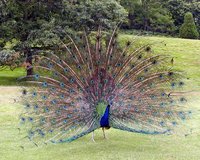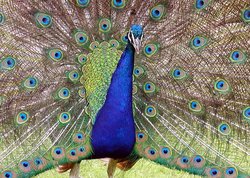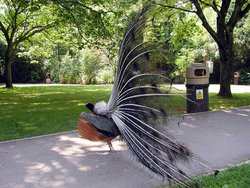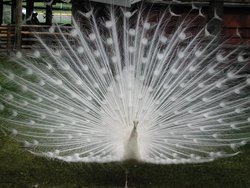Peafowl
|
|
- Peacock re-directs here; for alternate uses see Peacock (disambiguation).
| Peafowl | ||||||||||||
|---|---|---|---|---|---|---|---|---|---|---|---|---|
 An Indian Peacock displaying. | ||||||||||||
| Scientific classification | ||||||||||||
| ||||||||||||
| Species | ||||||||||||
|
Pavo cristatus |
The peafowl are the three species of bird in the genera Pavo and Afropavo of the pheasant family, Phasianidae. They are most notable for the male's extravagant tail, a result of sexual selection, which it displays as part of courtship. The male is called a peacock, the female a peahen. In common English usage, however, "peacock" is used to mean any peafowl.
The species are:
- Indian Peafowl, Pavo cristatus
- Green Peafowl, Pavo muticus
- Congo Peafowl, Afropavo congolensis
Peafowl are an ancient and isolated group of largely terrestrial Galliform birds belonging to the Pavoninidae.
| Contents |
Overview
The typical Asiatic peafowl belonging to the genus Pavo include the familiar Indian Peafowl, Pavo cristatus and the poorly known Dragonbirds or Green Peafowl Pavo muticus. Some biologists believe that there are at least five distinctive and critically endangered species of Green Peafowl while others categorize them into a single species with three subspecies.
The Arakan Dragonbird Pavo spicifer was once native to Northern Western Myanmar, Southern Tibet and Assam. The Indo-Chinese or Siamese Dragonbird Pavo imperator was once native to South East Myanmar and Thailand. The Annametic Dragonbird Pavo annamensis inhabited the broadlieaf evergreen forests of Cambodia, Vietnam, Laos and Southern Yunnan China.
The Javanese Green Peafowl, Pavo javanensis is native only to the island of Java. The extinct Malay or Pahang Peafowl Pavo muticus muticus was believed by early naturalists to be identical to the species found on Java. The two are not identical and the peafowl's presence in the fossil record of Java from at least the Pliocene rules out an introduction by humans. Northern Yunnan is the home of one of the most intriguing forms of Green Peafowl. The Yunnan Dragonbird, Pavo yunnanensis is most distinctive.
Missing image Lightmatter_peacock_tailfeathers_closeup.jpg Closeup of a peacock's tailfeathers |
Missing image Peacock_DSC04082.jpg When it is not in display, the long tail rests on the ground and hampers the movements of the peacock |
Peafowl are in nature omnivorous consuming plant parts, flower petals and seed heads when available, but insects and other arthropods are the preferred diet. Vegetable matter provides peafowl with the necessary fiber required to digest hard scales and bones of small reptiles. Unlike the somewhat similar Ring-neck Pheasant, Peafowls are obligate predators. This means, that animal protein is a real necessity for health and reproduction.
Asiatic peafowls like the Indian Peafowl and especially the Dragonbirds or Green Peafowls, occupy a similar niche as the Roadrunner, Secretary Bird and Seriama. All of these birds hunt for small animals, minnows, and arthropods on the ground, in shallow streams and frequently in tall grass habitats. Small snakes and other reptiles are the preferred diet of wild peafowl.
Like the Secretary Bird, the Green peafowl dispatches venemous snakes by agitating the reptiles into striking blindly, exhausting them. The peafowl subjugates its prey by flogging with the hard legs and wings. The kicking thorns or metatarsal spurs are also used for defense against predators.
Peafowls inhabit tropical savannah and riparian forests where they hunt for small animals in close social units of related birds that may span many generations.
Though it is often written that peafowl are polygynous in nature, it is almost impossible to distinguish juvenile and subadult green peafowls from their mothers. There is some anectodotal evidence suggesting that green peafowl may have very complex social lives that may include the adoption of one and two year old juveniles by their three and four year old sub-adult siblings.
In captivity, Green Peafowls and African Peafowl are monogamous with males assisting in nest defense, chick rearing, and chick brooding. The male's bond with offspring may extend indefinitely. First year chicks that have been weaned by their mothers generally join their father's social unit to forage and rest.
Peafowl are unusual amongst the Galliformes in their capacity for sustained flight.
All known genera of the peafowl family exhibit complex flight displays. The Great Argus has the largest wing surface area of any living bird and makes use of this in slow motion circling glides. The Crested Argus pairs fly together in unison to reach their towering nocturnal perches.
Each distinctive form of Green Peafowl has its own respective wing shape and flight display behavior.
Green Peafowls in Java are often observed flying out to sea where the birds gather on islets some miles from shore.
African Peafowl have unusually large wings in relation to their weight. The wings have a highly unusual shape as well. The African Peafowl or Afropavo wing is prominently marked in both sexes in patterns and colours which act as heliographs while in motion.
All known species of peafowl perch on emergent trees that stand above the canopy.
Peafowl differ from pheasants but are similar to monals and tragopans in their ability to climb altitudinally on the wing so that they may have sufficient lift to enable soaring.
Plumage
The male (peacock) has beautiful iridescent blue-green or green coloured plumage. His tail feathers have a series of eyes that are best seen when the tail is fanned. Both species have a head crest.
The female (peahen) has a mixture of dull green, brown and grey in her plumage. She lacks the long tail of the male, but has a crest.
Females can also display their plumage, to ward off danger to her young, or other female competition.
Many of the brilliant colors of the peacock plumage are due to an optical interference phenomenon (Bragg reflection) based on (nearly) periodic nanostructures found in the barbules (fiber-like components) of the feathers.
Different colors correspond to different length scales of the periodic structures. For brown feathers, a mixture of red and blue is required—one color is created by the periodic structure, while the other is a created by a Fabry-Perot interference peak from reflections off the outermost and innermost boundaries of the periodic structure.
Such interference-based structural color is especially important in producing the peacock's iridescent hues (which shimmer and change with viewing angle), since interference effects depend upon the angle of light, unlike chemical pigments.
In captivity, the peafowl has produced many plumage colour variations. Those are mutations that have been secured by selective breeding. They included: white bodied, barred winged, white eyed, pied, cameo, charcoal, bronze, opal, peach, midnight, purple, and any combination of these variations.
Courtship
Missing image Peacock_courting_peahen.jpg A Peacock attempts to court with a Peahen Missing image 12_18_2004_3_10_PM_0001.jpg A Peahen showing her plumage |
Peafowl are capable of reproducing at the age of 2. Peacocks do not reach full maturity until one year later. At the age of 2, the feathers are not fully developed in length and density. While peacocks at that are physiologically able to mate with peahens, they have very little chance of competing with older peacocks with larger feathers. At the age of 3, Peacocks' feathers reach maximum length for their lives, other than when they molt in the late summer.
Mating season starts in the early spring and ends in the early autumn. The peacock's courtship rituals include the display of its startling plumage and a loud call, the male's call sounds similar to an overemphasized cats "meow", whereas the female's call sounds similar to a dogs "arf" bark. Other peacocks have different calls as heard in this Indian Peacock video (491KB in MPEG-4 format). The peacock shakes his feathers in the direction of a peahen in close proximity to gather her attention. Peacocks are polygamous - they can mate with 4 or 5 peahens in a mating season, although they can be happy with one.
If successful in mating, the peahen will lay an average of 4 to 7 eggs, which hatch after 28 to 30 days.
Range
The Indian Peafowl (peacock) is native to India, where it is the national bird and Sri Lanka. The Green Peafowl breeds from Myanmar east to Java. The IUCN lists the Green Peafowl as vulnerable to extinction due to hunting and a reduction in extent and quality of habitat. The two Pavo species will hybridize.
The peafowl are forest birds which nest on the ground. They eat mainly seeds, but also some insects and fruit. The Pavo peafowl are terrestrial feeders, but roost in trees. They are reluctant fliers other than to access their roosts.
External Links and References
- Steven K. Blau (Jan. 2004), “Light as a Feather: Structural Elements Give Peacock Plumes Their Color (http://www.aip.org/pt/vol-57/iss-1/p18.html)”, Physics Today 57 (1), 18–20.
- World Birds Taxonomic List (http://www.zoonomen.net/avtax/gall.html) as of 2003-02-21
- Peafowl Variants Database (http://peacockgirl.tripod.com/Peafowl_Variet/Database_Homex.html)
- Peafowl Today (http://www.peafowl.org/ARTICLES/index.htm) Knowledge Base
- Peacocks Swarm Couple's Florida Home (http://www.cbsnews.com/stories/2005/05/31/eveningnews/main698813.shtml) - Feral peafowls became pests for one Florida couple in 2005de:Pfau



